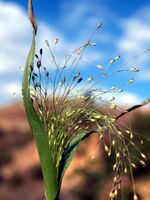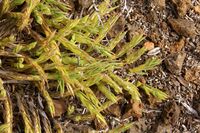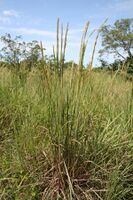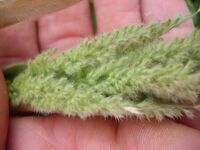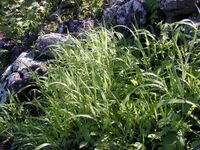Biology:Panicum
| Panicum | |
|---|---|
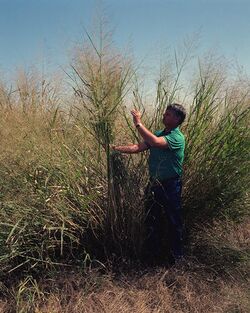
| |
| P. virgatum | |
| Scientific classification | |
| Kingdom: | Plantae |
| Clade: | Tracheophytes |
| Clade: | Angiosperms |
| Clade: | Monocots |
| Clade: | Commelinids |
| Order: | Poales |
| Family: | Poaceae |
| Subfamily: | Panicoideae |
| Supertribe: | Panicodae |
| Tribe: | Paniceae |
| Subtribe: | Panicinae |
| Genus: | Panicum L. |
| Synonyms[1] | |
| |
Panicum (panicgrass)[2] is a large genus of about 450 species of Poaceae grasses native throughout the tropical regions of the world, with a few species extending into the northern temperate zone. They are often large, annual or perennial grasses, growing to 1–3 m (3–10 ft) tall.[3][4]
The flowers are produced in a well-developed panicle often up to 60 cm (24 in) in length with numerous seeds, which are 1–6 mm (0.04–0.24 in) long and 1–2 mm (0.04–0.08 in) broad. The fruits are developed from a two-flowered spikelet. Only the upper floret of each spikelet is fertile; the lower floret is sterile or staminate. Both glumes are present and well developed.[5][6][7][8][9][10]
Australia has 29 native and 9 introduced species of Panicum.[11][12][13]
Well-known species include P. miliaceum (proso millet) and P. virgatum (switchgrass).
Selected species
Formerly classified in this genus, according to The Plant List:
Gallery
-
P. maximum
-
P. miliaceum (Proso)
-
P. phragmitoides
-
P. torridum
-
P. xerophyllum
-
P. trichoides
References
- ↑ Kew World Checklist of Selected Plant Families. Kew Gardens.
- ↑ "Panicum". Natural Resources Conservation Service PLANTS Database. USDA. https://plants.usda.gov/core/profile?symbol=PANIC.
- ↑ Freckmann, R. W. & M. G. Lelong. 2002. Nomenclatural changes and innovations in Panicum and Dichanthelium (Poaceae: Paniceae). Sida 20(1): 161–174
- ↑ Valdes, B. & H. Scholz. 2006. "The Euro+Med treatment of Gramineae - a generic synopsis and some new names". Willdenowia 36(2): 657–669
- ↑ Flora of China Vol. 22 Page 504 黍属 shu shu Panicum Linnaeus, Sp. Pl. 1: 55. 1753.
- ↑ Flora of Pakistan
- ↑ Altervista Flora Italiana, genere Panicum includes photos and distribution maps of several species
- ↑ Biota of North America Program 2013 county distribution maps
- ↑ Valdés-Reyna, J., F. O. Zuloaga, O. Morrone & L. Aragón Melchor. 2009. "El género Panicum (Poaceae: Panicoideae) en el noreste de México". Boletín de la Sociedad Botánica de México 84: 59–82.
- ↑ Morrone, O., A. M. Antón & F. O. Zuloaga. 1995. "Axonopus". Flora Fanerogámica Argentina. 19(1): 11–16
- ↑ Grasses of the Tweed Valley of NSW: An introductory field guide to locally common grasses: native and introduced, compiled by Penny Watsford, Nullum Publications, 2004 ISBN:0-9756823-0-X)
- ↑ Ausgrass2, Grasses of Australia
- ↑ "Atlas of Living Australia". Atlas of Living Australia. http://bie.ala.org.au/species/urn:lsid:biodiversity.org.au:apni.taxon:411937#tab_classification.
- ↑ *Britton, Nathaniel; Brown, Addison (1896). An illustrated flora of the northern United States, Canada and the British Possessions From Newfoundland to the Parallel of the Southern Boundary of Virginia, and from the Atlantic Ocean Westward to the 102d Meridian. I, Ophioglossaceae to Aizoaceae. Charles Scribner's Sons. pp. 612. https://archive.org/details/anillustratedfl01browgoog. page 123
External links
Wikidata ☰ Q934037 entry
 |

